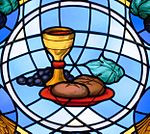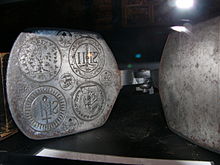Sacramental bread
This article needs additional citations for verification. (October 2021) |

Sacramental bread, also called Communion bread, Communion wafer, Sacred host, Eucharistic bread, the Lamb or simply the host (
Catholic theology generally teaches that at the Words of Institution the bread's substance is changed into the Body of Christ (transubstantiation), whereas Eastern Christian theology generally views the epiclesis as the point at which the change occurs. Bread was in the religious rituals of
Christianity
| Part of a series on the |
| Eucharist |
|---|
 |
Etymology of host
The word host is derived from the
Eastern traditions
With the exception of Churches of the
Armenian rite
Because leaven is symbolic of sin,[
Eastern Orthodox Churches
The baking may only be performed by a believing Orthodox Christian in good standing, having preferably been recently to Confession, and is accompanied by prayer and fasting. Before baking, each loaf is formed by placing two disks of dough, one on top of the other, and stamping it with a special liturgical seal. The prosphora should be fresh and not stale or moldy when presented at the altar for use in the Divine Liturgy.
Often several prosphora will be baked and offered by the faithful, and the priest chooses the best one for the
Eastern Catholic Churches

The Byzantine Rite Eastern Catholic Churches (like the Eastern Orthodox Church) use leavened bread for prosphora (the Greek word for Eucharistic altar bread).[3]
The Maronite Church has adopted the use of unleavened bread due to liturgical Latinisation. The Syro-Malabar Church uses both unleavened bread as well as leavened bread in which Holy Malka is added.[citation needed]
Western traditions
Catholic Church

A host is a portion of bread used for
In the
Hosts are often made by nuns as a means of supporting their religious communities. However, in New Zealand, the St Vincent de Paul Society hires individuals with intellectual disabilities to bake, cut out, and sort the bread, thereby offering paid employment to those who would not otherwise have that option.[5]
The General Instruction of the Roman Missal §321 recommends that "the eucharistic bread ... be made in such a way that the priest at Mass with a congregation is able in practice to break it into parts for distribution to at least some of the faithful. ... The action of the fraction (breaking of bread), which gave its name to the Eucharist in apostolic times, will bring out more clearly the force and importance of the sign of unity of all in the one bread, and of the sign of charity by the fact that the one bread is distributed among the brothers and sisters."[6]
In 1995 Cardinal Joseph Ratzinger (the future
Protestantism
In the varying
The
Some, such as the Churches of Christ, use matzo.[11]
Latter-day Saints
The Church of Jesus Christ of Latter-day Saints has no strict rules on the type of bread used for sacramental purposes. Latter-day Saint scriptures state: "For, behold, I say unto you, that it mattereth not what ye shall eat or what ye shall drink when ye partake of the sacrament, if it so be that ye do it with an eye single to my glory—remembering unto the Father my body which was laid down for you, and my blood which was shed for the remission of your sins." (Doctrine and Covenants 27:2) Different congregations may use either commercial bread or homemade bread prepared by members of the congregation. It is permissible to substitute rice cakes or other gluten-free breads for members who suffer from food allergies.[12] The bread is broken into fragments just prior to being blessed by one of the officiating priests.
Mandaeism
In
Some Mandaean ritual ceremonies also require the use of a small, round, saltless, half-baked biscuit called the
See also
- Bread stamp (signum pistoris)
- Host desecration
- Prosphora
Notes
- ^ Willoughby, H. R. (2008) [1929]. Pagan Regeneration: A Study of Mystery Initiations in the Graeco-Roman World. United Kingdom: Wipf and Stock Publishers.
- ^ Carpenter, E. (1920). Pagan & Christian Creeds: Their Origin and Meaning. Harcourt, Brace.
- EBSCOhost.
- ^ Code of Canon Law - Book IV - Function of the Church Liber (Cann. 879-958)
- ^ "Altar Breads". Wellington, New Zealand: Society of St Vincent de Paul. Archived from the original on 21 March 2018. Retrieved 18 March 2018.
- ^ Roman Missal §321
- ^ a b "Low-Gluten Diet Alternatives Have Reached A New Frontier: The Catholic Church". ThinkProgress. Archived from the original on 2015-01-03. Retrieved 2015-01-03.
- PMID 25922672.
- S2CID 20270743.
A lack of symptoms and/or negative serological markers are not reliable indicators of mucosal response to the diet. Furthermore, up to 30% of patients continue to have gastrointestinal symptoms despite a strict GFD. If adherence is questioned, a structured interview by a qualified dietitian can help to identify both intentional and inadvertent sources of gluten.
- ISBN 978-0300105070.
- ^ Wecker, Menachem. "Matzah Communion". American Jewish Life Magazine. Archived from the original on 2016-03-14. Retrieved 16 April 2017.
- ^ Christianson, Thira. "Accepting Allergies". Friend. Church of Jesus Christ of Latter-day Saints. Retrieved 10 November 2011.
- ^ OCLC 65198443.
Further reading
- Tony Begonja, Eucharistic Bread-Baking As Ministry, San Jose: Resource Publications, 1991, ISBN 0-89390-200-4.
External links
 Media related to Hosts at Wikimedia Commons
Media related to Hosts at Wikimedia Commons- New Advent Catholic Encyclopedia: Altar Breads
